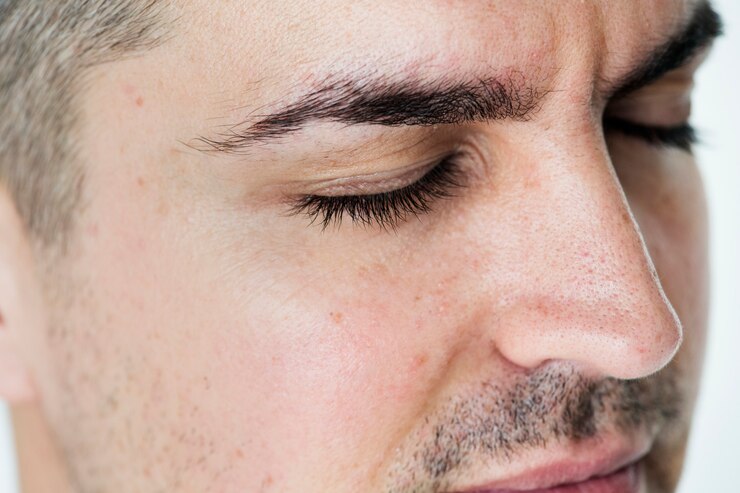
Acne between your eyebrows can be embarrassing, but it's also common—up to 80% of people get it at some point. It happens when oil glands under your skin clog up with dead skin cells and dirt, making blackheads and whiteheads. The most common culprits are rubbing your eyes or touching your face too much (like when you're studying for a test), but it can also be caused by genetics or poor skin care habits like not washing your face enough.
Although it can be embarrassing, acne between the eyebrows is usually not serious and doesn't require treatment by a doctor. However, it can cause problems if left untreated or become more severe.
In this blog post, we will explain acne between the eyebrows and how it affects people with it. We'll also cover some of the treatments available for acne in this area and tips for preventing them.
What is Acne?
Acne is a skin condition that causes pimples, blackheads, and whiteheads. You can get acne when your hair follicles get clogged with oil (sebum) and dead skin cells. The bacteria on your face then feed on the oils and dead skin cells, causing inflammation that leads to redness and swelling.
Acne often occurs at puberty because of changes in hormone levels. These fluctuations cause the sebaceous glands to produce more oil than usual, which clogs pores and causes breakouts.
Causes of Acne Between Eyebrows
Acne between the eyebrows can be caused by several factors, including:
Hormonal Imbalances
Hormonal imbalances can cause acne between the eyebrows because hormones help regulate oil production in your body. When you have an imbalance in your hormones, it can lead to greater oil production, resulting in pimples on your face.
Poor diet and nutrition
Poor diet and nutrition are common causes of acne between the eyebrows because they can lead to clogged pores and breakouts. If you're eating foods that are high in sugar and salt, this can cause excess oil production, which could result in breakouts.
Poor hygiene
Poor hygiene is another common cause of acne between your brows because it allows bacteria to grow on your skin which causes inflammation or redness when infected by bacteria such as staphylococcus epidermidis - a common bacteria found on human skin!
This type of bacteria thrives under warm conditions like those found on your forehead, so keeping yourself clean helps prevent these infections from forming there too!
Skincare products
The area between your eyebrows is one of the most sensitive parts of your face, so it's important to be careful with what you put on there. The skin in that area can easily absorb more product than other areas of your face, which means that using too much moisturizer or other skincare products can make acne worse.
If you're using a new product and noticing an increase in acne breakouts, try decreasing your use until you see a difference.
Stress
Stress is another common cause of acne between eyebrows. When you're stressed out, your body produces more hormones that cause inflammation in your skin and hair follicles, which can lead to pimples.
Symptoms of Acne Between Eyebrows
Acne between the eyebrows is a common condition caused by stress, hormones, or lack of sleep. It can also be triggered by certain medications or skincare products that don't work well with your skin.

If you have acne between your eyebrows, you may experience:
Redness
: Redness is a common symptom of all types of acne, so if you see redness in this area, it may indicate an inflamed pore or cyst that needs to be treated, therefore, a consultant by a dermatologist is necessary.Swelling
: Swelling can also be a sign of inflammation or infection, so if there's swelling around the area where your eyebrows meet, it's best to consult a doctor who can help diagnose and treat it.Pain
: Acne doesn't just cause redness and swelling—it can also cause pain. If you experience sharp pain or burning when touching this area, it could mean an abscess forming under the skin that needs treatment from a doctor.Pus-filled bumps
: Cysts and nodules form under the skin when inflammation or infection is present. Suppose you see pus-filled bumps forming around these areas.Blackheads
: Blackheads look like small dark spots on the skin and are often near hair follicles. The black color comes from oxidized oil trapped under the skin's surface when dead skin cells clog up pores.
You may want to visit a dermatologist for a diagnosis if your symptoms are bothersome and or if they get worse. The best way to prevent acne is to keep your skin clean and to avoid touching or picking at it.
Prevention of Acne Between Eyebrows

Keep the area clean
Keeping your skin clean is one of the most important steps in preventing acne. Wash your face twice daily with a mild cleanser and warm water, and avoid scrubbing or exfoliating it too much. This can irritate your skin and make it more susceptible to developing acne.
Avoid overuse of skincare products.
Many people with acne use too many skincare products, which can clog pores and lead to breakouts. If you have this problem, try using less makeup or skincare products until your skin improves, then gradually add more as needed. Try to maintain a healthy diet and lifestyle.
Maintain a healthy diet and lifestyle
A balanced diet rich in fruits and vegetables can help reduce inflammation, which may reduce acne outbreaks. Also, consider cutting back on foods that cause inflammation (such as dairy & processed foods) or trigger allergic reactions (like peanuts or cashew nuts).
Reduce stress levels
It's no secret that we all have a lot on our plates, but if you're stressed and anxious, your body releases cortisol into your bloodstream. This hormone has been linked to breakouts because it causes the skin cells in your hair follicles to grow faster than normal, leading to inflammation and pimples. Therefore, avoid inviting unnecessary stress into your life.
Use non-comedogenic products
If you have oily skin, you may be tempted to use products not designed for oily skin types. These products can worsen your skin, so using only non-comedogenic products when treating acne is important.
Treatment of Acne Between Eyebrows
Acne treatment between the eyebrows can be done in several ways, depending on the severity of the acne and how long it has been present. Some options include:
Topical treatments
Topical treatments are enough to clear up mild acne between the eyebrows. Topical medications work by reducing inflammation and increasing blood flow to the skin. This allows your body's natural healing processes to speed up so that pimples heal faster and more thoroughly than they would otherwise.
Oral medication
Oral medication is often necessary for moderate-to-severe cases of acne between the eyebrows. These medications are typically taken over several months or even years to keep breakouts from recurring after they've cleared up with topical treatment alone.
They can also be used alongside topical treatments for maximum effectiveness against stubborn breakouts that don't respond well to one method alone (such as laser therapy). Oral medications include Tetracycline, Erythromycin, Doxycycline, Minocycline, Dapsone, and Isotretinoin (Accutane). But, none of these treatments should be commenced before visiting a dermatologist.
Laser therapy
Laser therapy is another option for clearing up acne between eyebrows; however, this treatment must be performed by a dermatologist specializing in this area of medicine so that safety precautions are followed properly every time it's done.
Laser therapy uses light energy from lasers to destroy bacteria and reduce inflammation to improve acne symptoms. It can cause redness or swelling at the treatment site for several days after treatment.
Home remedies
Home remedies for acne between eyebrows are often just as effective as going to the dermatologist. The best way to treat acne between your eyes is with benzoyl peroxide, which can be found in many over-the-counter acne treatments. Since, it can irritate the skin, so it is always preferable to initially visit a dermatologist before using it.
Another effective home remedy is tea tree oil, which you can use by applying a few drops directly to the affected skin area and massaging it gently. Tea tree oil is known for its antibacterial properties and is effective against many forms of acne.
Dermatologist Consultation
If none of these methods work for you, it may be time to consult a dermatologist about other options for treating your acne between eyebrows. They'll be able to examine your facial skin closely and determine what kind of treatment would work best for you. So, it is always better to get a consultation to get a treatment that’s tailored exclusively for you!
Best Practices for Managing Acne Between Eyebrows
Avoid picking or popping the pimples.
Avoiding picking or popping the pimples is one of the best practices for managing acne between eyebrows. Picking or popping your pimples can cause scarring, making your acne worse in the long run. The best thing to do is leave it alone and let it heal.
Do not touch your face.
You should also avoid touching or rubbing your face too much when it's prone to acne between the eyebrows, as this could further irritate the skin or spread bacteria to other areas of your face.
Follow a consistent skincare routine.
You should also follow a consistent skincare routine when treating acne between your eyebrows: wash twice daily with a gentle cleanser; apply an over-the-counter acne treatment like benzoyl peroxide but after consulting a dermatologist ; use a moisturizing lotion on dry patches, and sleep on clean sheets every night. But, use water-based moisturiser and other non-comedogenic products if you have oily skin.
To wrap it up…
We hope this guide has helped you understand how to manage and treat acne between your eyebrows. Overall, acne between eyebrows can significantly impact your self-esteem and quality of life but it can be managed and treated effectively with proper care and treatment.
Early treatment is essential to prevent scarring and other unwanted side effects from occurring. You must consult a dermatologist if you want to get the best care possible for your condition.





